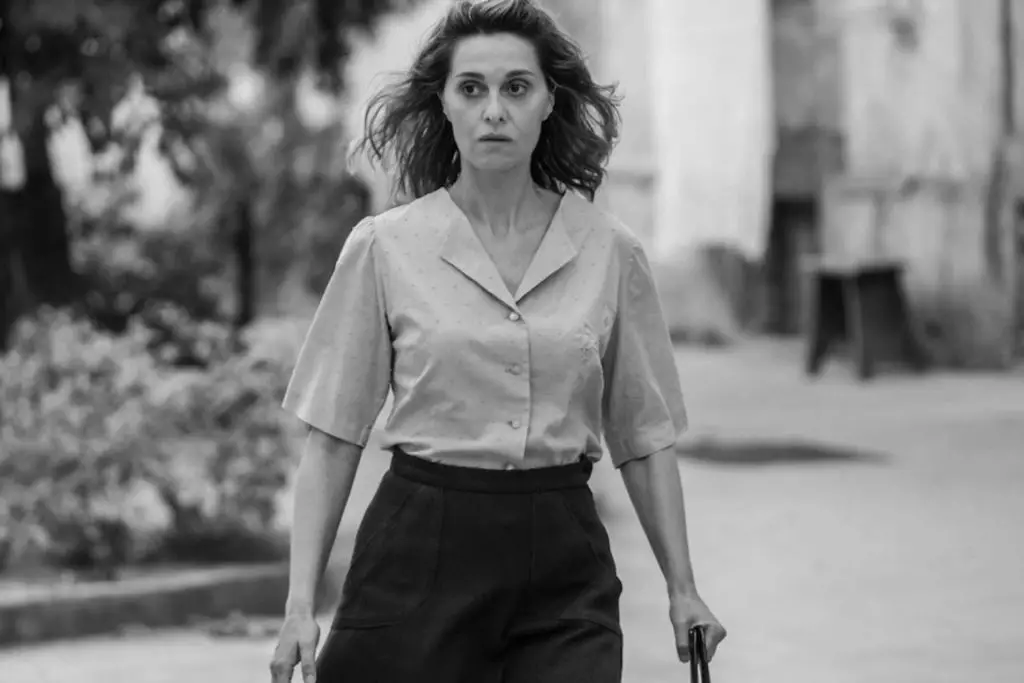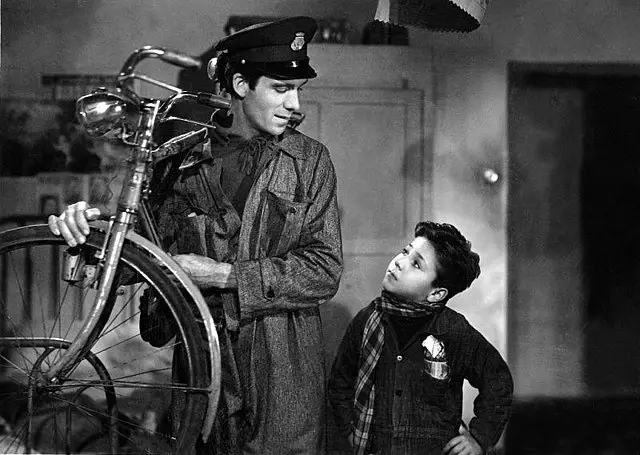“C’è ancora domani” (There’s still tomorrow) is a 2023 Italian film directed by Paola Cortellesi, marking her directorial debut. The film is set in post-World War II Rome and follows Delia, a woman navigating the harsh realities of domestic life while striving for a better future.
C’è ancora domani: historical context
The film is deeply rooted in the historical context of 1946 Italy, a period characterized by the country’s recovery from the devastation of World War II. This era was marked by significant social and economic upheaval, with traditional family structures and gender roles being questioned and transformed. The neorealist style of the film, reminiscent of works by Vittorio De Sica and Roberto Rossellini, helps anchor the story in its historical moment while highlighting the universal struggles of its characters.

Characters
Delia, played by Paola Cortellesi herself, is the central character. She embodies the plight of many women of her time who were confined to domestic roles yet harbored dreams and aspirations beyond their immediate circumstances. Delia’s husband, Ivano (Valerio Mastandrea), represents the patriarchal authority and traditional masculinity that oppress her. Despite his often violent and abusive behavior, Ivano is portrayed with some complexity, suggesting that he too is a product of his time and environment. Other characters include Delia’s best friend Marisa (Emanuela Fanelli), who offers emotional support, and Nino (Vinicio Marchioni), a suitor from Delia’s past who dreams of a better life with her. These characters provide Delia with glimpses of hope and alternative futures, contrasting with the oppressive reality of her domestic life.
C’è ancora domani: social framework
The film’s social commentary is robust, addressing themes of feminism, patriarchy, and social change. Delia’s struggle against her abusive husband and oppressive societal norms reflects the broader feminist discourse, particularly the fight for women’s rights and self-determination. The film’s black-and-white cinematography and period-specific details enhance its authentic portrayal of the era’s social conditions. By focusing on Delia’s personal journey, Cortellesi underscores the collective struggle of women during this period. The film critiques the entrenched patriarchal values that dictated women’s lives, highlighting the slow but inevitable march towards gender equality. It also touches on issues like domestic violence and the limited economic opportunities for women, which remain relevant today.
Psychological frame
Psychologically, “C’è ancora domani” delves into the resilience and inner strength of its characters. Delia’s journey is one of self-discovery and empowerment. Despite the constant abuse and humiliation, she finds small ways to assert her dignity and autonomy, symbolized by her secret dreams and the unexpected letter that sparks a glimmer of hope. The film’s ability to blend neorealism with light-hearted moments, even during violent scenes, adds a unique layer to its psychological exploration. This juxtaposition of comedy and drama highlights the absurdity of the characters’ suffering while making a poignant statement about their resilience and hope.
The Mother-daughter relationship in “C’è ancora domani”
In “C’è ancora domani,” the relationship between Delia and her daughter Marcella (Romana Maggiora Vergano) is a central theme that underscores the generational dynamics and societal expectations placed on women. Set against the backdrop of post-World War II Rome, their relationship reflects the tension between traditional roles and the desire for a better future. Delia, portrayed by Paola Cortellesi, is a resilient woman enduring domestic violence and societal oppression. Her primary concern is to secure a brighter future for Marcella, hoping that her daughter will escape the cycle of abuse and subjugation that she faces. Delia’s sacrifices and quiet strength are motivated by her deep love for Marcella and her determination to provide her with opportunities she never had. Marcella, on the other hand, represents the new generation with aspirations of social mobility and personal freedom. She is on the cusp of adulthood, facing the pressures of conforming to societal expectations while yearning for independence. Her relationship with Delia is complex; it is marked by a mix of admiration, frustration, and a deep-seated desire to break free from the constraints that bind her mother. The film delicately portrays their bond through everyday interactions and pivotal moments. Delia’s protective nature often clashes with Marcella’s youthful defiance, yet their mutual love and respect are evident. This dynamic is poignantly captured in scenes where Delia encourages Marcella’s ambitions, subtly imparting her own hopes and dreams onto her daughter. Critically, their relationship also serves as a lens to explore broader themes of feminism and self-determination. Delia’s efforts to shield Marcella from patriarchal oppression highlight the generational shift in attitudes towards gender roles. As Delia fights for her daughter’s future, she embodies the collective struggle of women seeking to redefine their place in society. In essence, the mother-daughter relationship in “C’è ancora domani” is a powerful narrative device that illustrates the personal and societal transformations of the time. It adds emotional depth to the film, making it a compelling study of resilience, hope, and the enduring bond between mother and daughter.
The interaction between Delia and her past love in “C’è ancora domani”
In “C’è ancora domani,” Delia’s interaction with Nino, her past love, introduces a significant subplot that adds depth to the narrative. This relationship not only explores Delia’s emotional landscape but also serves as a vehicle for examining themes of hope, escape, and the lingering influence of past relationships.

Nino’s character and his role
Nino, played by Vinicio Marchioni, is a figure from Delia’s past who reappears with aspirations of rekindling their romance and providing her with an escape from her oppressive life. His character symbolizes the possibility of a different future, one that contrasts sharply with the grim reality of Delia’s current existence. Nino’s presence brings back memories of a time when Delia’s life held more promise and potential, before it was overshadowed by the harshness of her marriage and domestic responsibilities. Nino proposes that Delia leave Rome and move with him to Northern Italy (Settentrione). This proposition is laden with implications. Northern Italy, historically more industrialized and economically prosperous than the south, represents opportunity and new beginnings. For Delia, Nino’s offer is not just a chance to escape her abusive husband but also an opportunity to reclaim a part of herself that has been lost over the years. Very significant and poetic, the scene where the two greedily share a piece of chocolate that they savour slowly and with their eyes closed like something forbidden, translatable into their unlived love. The idea of moving to Northern Italy is both tempting and terrifying for Delia. It embodies the hope for a better tomorrow, which is a central theme of the film. Yet, it also requires her to confront her fears and the societal norms that have kept her bound to her current life. Delia’s internal struggle with this decision highlights her desire for self-determination and her conflict with the constraints imposed by her social environment.
Emotional and psychological dynamics
Delia’s interactions with Nino reveal much about her character’s emotional and psychological state. She is torn between her duty as a mother and her yearning for personal freedom and happiness. Nino’s affection and the memories of their past provide a stark contrast to the violence and degradation she experiences at home. This contrast emphasizes the psychological impact of her current life and the potential for healing and happiness that Nino represents. Their relationship also touches on themes of regret and lost opportunities. Delia reflects on what might have been had she chosen a different path. This reflection is crucial for her character development, as it forces her to evaluate her life’s choices and consider the possibility of change. Nino, in this sense, acts as a catalyst for Delia’s introspection and growth.
The encounter with the American soldier
In “C’è ancora domani,” Delia’s encounter with William, an American soldier played by Yonv Joseph, becomes a pivotal moment in the film. William represents a beacon of hope and an opportunity for change in Delia’s constrained life. His presence introduces a new perspective and a potential escape from the oppressive environment that Delia endures daily. Their meeting occurs serendipitously, and William’s kindness and empathy contrast sharply with the abusive behavior of Delia’s husband, Ivano, and her father-in-law. William offers Delia not only physical assistance but also emotional support, affirming her worth and dignity. This relationship underscores the themes of cross-cultural interaction and the transformative power of empathy and kindness. At one point William takes care of blowing up the bar of the family of Marcella’s future husband, helping Delia to free her daughter from a promise of marriage to a man similar to Ivano. In essence, the inclusion of William’s character in “C’è ancora domani” not only enhances the narrative’s emotional depth but also reinforces the film’s broader themes of hope, resilience, and the quest for a better tomorrow. His impact on Delia’s life illustrates the importance of solidarity and the profound effect that compassion and support can have on an individual’s path to empowerment.
The Connection between “C’è ancora domani” and the Cinema of Rossellini and De Sica
“C’è ancora domani” (There’s Still Tomorrow) by Paola Cortellesi establishes a profound connection with the works of Italian neorealist filmmakers Roberto Rossellini and Vittorio De Sica. This connection is evident in various aspects of the film, including its thematic focus, stylistic choices, and narrative approach.

Thematic focus
Neorealism, as exemplified by Rossellini and De Sica, often focused on the everyday lives of ordinary people, particularly in the aftermath of World War II. These films highlighted the struggles of the lower and working classes, bringing to light social issues such as poverty, unemployment, and the resilience of the human spirit. “C’è ancora domani,” set in 1946 Rome, follows Delia as she navigates domestic violence and societal oppression. This thematic exploration of personal and social struggles mirrors the focus of neorealist films like Rossellini’s “Rome, Open City” (1945) and De Sica’s “Bicycle Thieves” (1948). In “Rome, Open City,” Rossellini portrays the harsh realities of life under Nazi occupation, emphasizing the courage and resilience of ordinary Italians. Similarly, “Bicycle Thieves” depicts a father’s desperate quest to recover his stolen bicycle, which is crucial for his employment and family’s survival. “C’è ancora domani” shares this commitment to realism and social commentary, depicting Delia’s efforts to secure a better future for herself and her daughter amidst post-war hardships.
Stylistic choices
Paola Cortellesi’s film employs stylistic elements that hark back to the visual and narrative techniques of neorealism. The decision to shoot in black and white enhances the historical authenticity and evokes the aesthetic of classic neorealist films. This choice not only situates the film within its historical context but also pays homage to the visual style of Rossellini and De Sica, who used black and white cinematography to convey a sense of realism and immediacy. Furthermore, “C’è ancora domani” incorporates a mixture of professional and non-professional actors, a hallmark of neorealism. This casting approach adds to the film’s authenticity and relatability, making the characters’ experiences more believable and impactful. The use of real locations rather than studio sets also aligns with the neorealist tradition, grounding the narrative in the tangible reality of post-war Rome.
Narrative approach
Neorealist films are known for their focus on simple, yet profound, human stories. They often eschew complex plots in favor of straightforward narratives that reveal deep social truths. “C’è ancora domani” follows this narrative simplicity, focusing on Delia’s day-to-day struggles and relationships. The film’s plot is driven by the characters’ interactions and emotional journeys rather than by intricate plot twists, much like in “Bicycle Thieves,” where the story revolves around the father’s efforts to reclaim his stolen bicycle. Moreover, the blend of drama and lighter, sometimes comedic moments in “C’è ancora domani” echoes the narrative balance found in neorealist works. Despite the serious subject matter, Cortellesi’s film incorporates moments of humor and warmth, reminiscent of the humanistic touch that Rossellini and De Sica often infused in their films. This blend of tones helps to highlight the resilience and hope that persist even in the most challenging circumstances.
The bottom line
Paola Cortellesi’s “C’è ancora domani” pays homage to the neorealist cinema of Roberto Rossellini and Vittorio De Sica through its thematic focus on social issues, its stylistic choices, and its narrative approach. By drawing on the neorealist tradition, Cortellesi not only situates her film within a significant historical context but also creates a timeless exploration of human resilience and the quest for a better tomorrow. “C’è ancora domani” is a significant film that offers a poignant and multifaceted exploration of postwar Italian society through the lens of one woman’s struggle. Paola Cortellesi’s directorial debut is both a homage to Italian neorealism and a fresh, modern take on its themes, making it a compelling narrative about resilience, hope, and the fight for a better tomorrow. The film’s success at the box office and its critical acclaim underscore its impact and relevance, resonating with audiences both in Italy and internationally.

